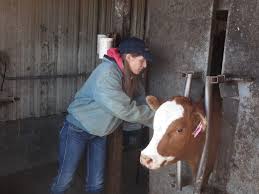
From Facts About Beef
Myth: Big beef uses antibiotics without regard for animal welfare or human health.
Facts: Antibiotics are just one tool beef farmers and ranchers use to keep cattle healthy by treating and preventing the spread of illness. Cattle can pick up illnesses, just like humans, whether they’re out on pasture or in a feedlot with other animals. Cattlemen work closely with veterinarians to develop a comprehensive health program, which may include nutritious diet, proper housing, hygiene, vaccinations and antibiotics.
Here are the basics on antibiotic use in cattle:
How are they used?
When an animal gets sick, farmers, ranchers and veterinarians carefully evaluate when to administer antibiotics and use specific dosages and treatment protocols to treat the animal.
Cattle farmers and ranchers believe not treating cattle that become sick is inhumane as part of their ongoing commitment to animal health and welfare. When administering antibiotics, they follow precise label directions, meaning they adhere to usage guidelines to protect both animals and humans that have been rigorously tested and approved by the United States Food & Drug Administration. Just like in human medicine, there are many protocols developed by veterinarians and scientists that they have to follow diligently.
Antibiotics are used in animal medicine to prevent disease, which is important to animal and human safety.
Antibiotic use to prevent disease differs from growth promotion purposes in three ways: dose, duration and level of veterinary oversight.
Some farmers and ranchers choose to use ionophores – a special class of antibiotics not used in human medicine – to promote lean muscle growth in animals, which results in leaner beef choices.
Who ensures antibiotics are not overused?
There is no reason to overuse antibiotics, but reasons why they might be used at specific times and in targeted ways. For one, it’s the law not to overuse them, but antibiotics also are expensive for the small businessmen and women who raise cattle for beef.
How are antibiotics given to cattle?
Depending on the circumstance, antibiotics may be given to cattle as individual injections or added to feed or water to treat a larger group who has been exposed to the same illness.
Are antibiotics safe?
All antibiotics must go through rigorous government scrutiny before being approved for use in livestock.
Unlike human medicine, animal medicine goes through three layers of approval, is the medicine safe for the animal, the environment and the humans who will consume the meat. All three areas must be evaluated before approval from the U.S. Food & Drug Administration.
Even after they’re approved, antibiotics are continuously monitored and must be re-evaluated annually. They only stay on the market if they continue to be proven safe.
What’s being done to improve antibiotic use?
Cattlemen and the entire livestock community are working together to continuously improve the way antibiotics are used in animals, because they care about how their practices impact antibiotic safety and efficacy.
The beef community is also working to avoid using antibiotics that are important to both human and animal medicine, as identified by the World Health Organization. For example, Food & Drug Administration Guidance 209 and 213 will eliminate growth promotion uses of medically important antibiotics and extend veterinary oversight.
For consumers who want beef raised without antibiotics, the beef community has listened and provides choices to meet those needs.
